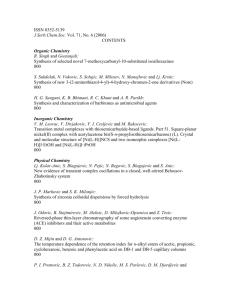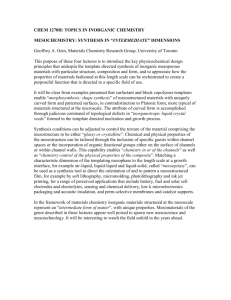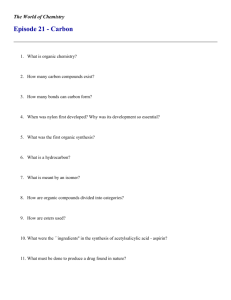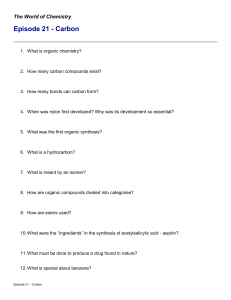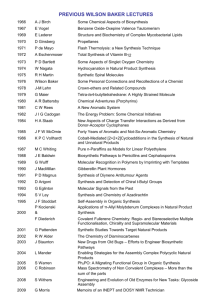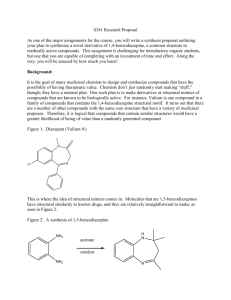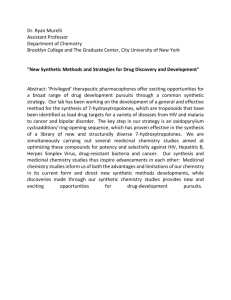B18OB Synthesis in Organic Chemistry - Heriot
advertisement
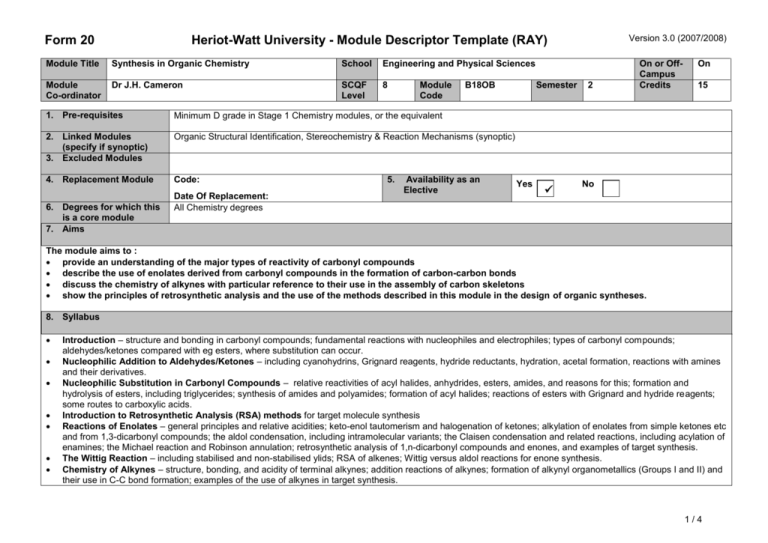
Form 20 Version 3.0 (2007/2008) Heriot-Watt University - Module Descriptor Template (RAY) Module Title Synthesis in Organic Chemistry School Engineering and Physical Sciences Module Co-ordinator Dr J.H. Cameron SCQF Level 8 Module Code B18OB 1. Pre-requisites Minimum D grade in Stage 1 Chemistry modules, or the equivalent 2. Linked Modules (specify if synoptic) 3. Excluded Modules Organic Structural Identification, Stereochemistry & Reaction Mechanisms (synoptic) 4. Replacement Module Code: 6. Degrees for which this is a core module 7. Aims Date Of Replacement: All Chemistry degrees 5. Availability as an Elective Semester Yes 2 On or OffCampus Credits On 15 No The module aims to : provide an understanding of the major types of reactivity of carbonyl compounds describe the use of enolates derived from carbonyl compounds in the formation of carbon-carbon bonds discuss the chemistry of alkynes with particular reference to their use in the assembly of carbon skeletons show the principles of retrosynthetic analysis and the use of the methods described in this module in the design of organic syntheses. 8. Syllabus Introduction – structure and bonding in carbonyl compounds; fundamental reactions with nucleophiles and electrophiles; types of carbonyl compounds; aldehydes/ketones compared with eg esters, where substitution can occur. Nucleophilic Addition to Aldehydes/Ketones – including cyanohydrins, Grignard reagents, hydride reductants, hydration, acetal formation, reactions with amines and their derivatives. Nucleophilic Substitution in Carbonyl Compounds – relative reactivities of acyl halides, anhydrides, esters, amides, and reasons for this; formation and hydrolysis of esters, including triglycerides; synthesis of amides and polyamides; formation of acyl halides; reactions of esters with Grignard and hydride reagents; some routes to carboxylic acids. Introduction to Retrosynthetic Analysis (RSA) methods for target molecule synthesis Reactions of Enolates – general principles and relative acidities; keto-enol tautomerism and halogenation of ketones; alkylation of enolates from simple ketones etc and from 1,3-dicarbonyl compounds; the aldol condensation, including intramolecular variants; the Claisen condensation and related reactions, including acylation of enamines; the Michael reaction and Robinson annulation; retrosynthetic analysis of 1,n-dicarbonyl compounds and enones, and examples of target synthesis. The Wittig Reaction – including stabilised and non-stabilised ylids; RSA of alkenes; Wittig versus aldol reactions for enone synthesis. Chemistry of Alkynes – structure, bonding, and acidity of terminal alkynes; addition reactions of alkynes; formation of alkynyl organometallics (Groups I and II) and their use in C-C bond formation; examples of the use of alkynes in target synthesis. 1/4 Form 20 Version 3.0 (2007/2008) Heriot-Watt University - Module Descriptor Template (RAY) Module Title Synthesis in Organic Chemistry School Engineering and Physical Sciences Module Co-ordinator Dr J.H. Cameron SCQF Level 8 Module Code B18OB Semester 2 On or OffCampus Credits On 15 9. Learning Outcomes (HWU Core Skills: Employability and Professional Career Readiness) Subject Mastery Understanding, Knowledge and Cognitive Skills Scholarship, Enquiry and Research (Research-Informed Learning) On completion of this module, the learner will be able to: Understand the main patterns of reactivity of compounds containing the carbonyl group Convert carboxylic acids into acyl chlorides, anhydrides, esters and amides, and interconvert these acyl derivatives Display an understanding of the use of enolates derived from carbonyl compounds in the formation of carbon-carbon bonds in the context of target synthesis Apply the concept of retrosynthetic analysis (RSA) to target structures which are amenable to synthesis using enolate chemistry, together with methods from prior knowledge, and to design syntheses of such target compounds Understand the use and power of the Wittig reaction in the synthesis of alkenes Appreciate the use of alkynes in organic synthesis, particularly for C-C bond formation Apply RSA to targets amenable to synthesis using alkyne chemistry and/or the Wittig reaction, and design syntheses of such targets Integrate previous knowledge from across all of chemistry with the topics discussed in the module 2/4 Form 20 Version 3.0 (2007/2008) Heriot-Watt University - Module Descriptor Template (RAY) Module Title Synthesis in Organic Chemistry School Engineering and Physical Sciences Module Co-ordinator Dr J.H. Cameron SCQF Level 8 Module Code B18OB Semester 2 On or OffCampus Credits On 15 Personal Abilities Industrial, Commercial & Professional Practice Autonomy, Accountability & Working with Others Communication, Numeracy & ICT Personal abilities are embedded in the module. The module provides the opportunity to : Critically review and consolidate knowledge, skills and practices in chemistry Analyse a problem in a systematic manner, and construct a solution Interpret, use and evaluate a wide range of data to solve problems of both a familiar and unfamiliar nature Present a logical summary of a complex topic Use ICT skills with on-line materials, assessments (formative and summative) and web links to support the learning process Apply strategies for appropriate selection of relevant information from a wide source and large body of knowledge Exercise initiative and independence in carrying out learning activities Manage time effectively, work to deadlines and prioritise workloads Develop oral communication abilities through small group tutorials Use and evaluate spectroscopic data for problem solving and structural elucidation Use molecular models and molecular modeling packages to visualize and understand structure Practice the extensive use of problem solving approach to encourage consolidation and application of structural concepts Use a VLE and other on-line Web sites and resources to enhance the student learning experience and promote independent learning Participate in tutorial sessions designed to promote discussion of course-related topics with professional-level colleagues. Use and evaluate numerical and graphical data Demonstrate numerical, graphical and problem-solving skills in a range of areas Communicate complex ideas and information effectively to a group of peers Practise the use of standard methods in the solution of routine chemical problems within familiar contexts Exercise some initiative and independence in carrying out defined problem solving activities Critically use mathematical methods to analyse various chemical reactions variables Interpret, use and evaluate a wide range of data to solve problems of both a familiar and unfamiliar nature Evaluate numerical and graphical data and apply them to the solution of chemical problems Manage resources in defined areas of activity Work with peers in small groups in the discussion of chemical problems 10. Assessment Methods 11. Re-assessment Methods Method Duration of Exam Weighting (%) Synoptic modules? Method Duration of Exam (if applicable) Synoptic Examination Class test Continuous Assessment Laboratory Work 3h 2h (if applicable) 50% 15% 15% 20% B18OA Synoptic Examination (100%) 3h 3/4 Form 20 Version 3.0 (2007/2008) Heriot-Watt University - Module Descriptor Template (RAY) Module Title Synthesis in Organic Chemistry School Engineering and Physical Sciences Module Co-ordinator Dr J.H. Cameron SCQF Level 8 Module Code B18OB Semester 2 On or OffCampus Credits On 15 12. Date and Version Date of Proposal 24 August, 2007 Date of Approval by School Committee Date of Implementation 15 September, 2008 Version Number 1.0 4/4
